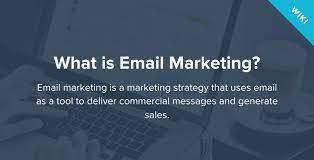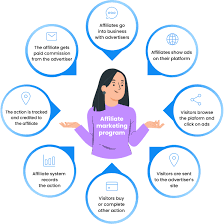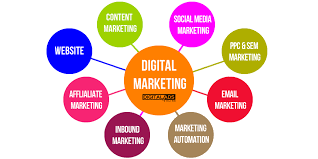Email Marketing: A Powerful Tool for Business Success
In today’s digital age, where technology is constantly evolving, email marketing remains one of the most effective and reliable methods for businesses to reach their target audience. But what exactly is email marketing?
Email marketing can be defined as the practice of sending commercial messages, typically in the form of emails, to a group of individuals who have expressed interest in receiving information about a particular product, service, or brand. It is a direct and personalized approach that allows businesses to connect with their customers on a more intimate level.
The power of email marketing lies in its ability to deliver targeted messages directly to the inbox of potential customers. Unlike other forms of advertising that rely on reaching out to a broad audience, email marketing enables businesses to tailor their messages based on customer preferences, demographics, or previous interactions. This level of personalization helps build trust and loyalty among recipients.
One key advantage of email marketing is its cost-effectiveness. Compared to traditional advertising channels such as TV or print media, sending emails requires minimal investment. With the right tools and strategies in place, businesses can achieve significant returns on their investment by driving sales and increasing customer engagement.
Another benefit of email marketing is its measurability. Through advanced analytics and tracking tools, businesses can monitor key metrics such as open rates, click-through rates, and conversions. This data provides valuable insights into customer behavior and allows businesses to refine their campaigns for better results.
Furthermore, email marketing offers unparalleled reach. With billions of people using email worldwide, businesses can tap into a vast pool of potential customers across different demographics and geographic locations. Whether it’s promoting a new product launch or sharing informative content with subscribers, email marketing enables businesses to expand their reach without boundaries.
However, it’s important for businesses to approach email marketing ethically and responsibly. Building an engaged subscriber list requires obtaining permission from individuals who willingly opt-in to receive emails. This ensures that recipients are genuinely interested in the content being sent, leading to higher engagement rates and fewer spam complaints.
In conclusion, email marketing is a powerful tool that allows businesses to connect with their audience in a direct and personalized way. It offers cost-effectiveness, measurability, and unparalleled reach. By leveraging the potential of email marketing, businesses can nurture customer relationships, drive sales, and ultimately achieve long-term success in today’s competitive marketplace.
A Comprehensive Guide to Email Marketing: FAQs and Best Practices
- What is email marketing?
- How does email marketing work?
- What are the benefits of email marketing?
- How do I start an email marketing campaign?
- What are the best practices for email marketing?
What is email marketing?
Email marketing is a digital marketing strategy that involves sending commercial messages, typically in the form of emails, to a group of individuals who have opted in to receive such communications. It is a targeted and personalized approach used by businesses to promote their products, services, or brand directly to their customers or potential customers.
The process of email marketing begins with building an email list comprised of individuals who have willingly provided their email addresses and granted permission to receive emails from the business. These email addresses are usually collected through sign-up forms on websites, during purchases, or through other lead generation methods.
Once an email list is established, businesses can create and send various types of emails based on their marketing objectives. These emails can include newsletters, promotional offers, product updates, event invitations, customer surveys, and more. The content and design of these emails are carefully crafted to engage recipients and encourage them to take desired actions such as making a purchase, visiting a website, or subscribing to additional services.
Email marketing offers several advantages for businesses. Firstly, it provides a direct line of communication with customers. By delivering messages directly into recipients’ inboxes, businesses can reach their audience without relying on external platforms or algorithms. This allows for greater control over the timing and delivery of marketing messages.
Secondly, email marketing enables businesses to personalize their messages based on recipient preferences and behaviors. By segmenting the email list and tailoring content specifically for different groups or individuals, businesses can increase engagement and conversion rates. Personalization may involve addressing recipients by name or providing customized recommendations based on previous purchases or interactions.
Additionally, email marketing allows for easy tracking and measurement of campaign performance. Businesses can analyze metrics such as open rates (the percentage of recipients who open the email), click-through rates (the percentage of recipients who click on links within the email), conversion rates (the percentage of recipients who complete desired actions), and more. This data provides valuable insights into campaign effectiveness and helps businesses optimize their strategies for better results.
Email marketing is a versatile and cost-effective marketing tool that can be used by businesses of all sizes and industries. It offers a direct, personalized, and measurable way to engage with customers, build brand loyalty, drive sales, and achieve business objectives. However, it is important for businesses to follow ethical practices by obtaining permission from recipients and respecting their preferences regarding email frequency and content.
How does email marketing work?
Email marketing works by utilizing a strategic approach to send targeted messages and promotional content directly to a group of individuals who have expressed interest in receiving information from a particular business or brand. Here’s how it typically works:
- Building an Email List: The first step is to build an email list of subscribers who have willingly provided their contact information and given permission to receive emails. This can be done through various methods, such as website sign-up forms, lead generation campaigns, or opt-in incentives like free downloads or exclusive offers.
- Segmentation: Once the email list is established, businesses can segment their subscribers based on demographics, interests, purchase history, or other relevant data. Segmenting allows for more personalized and targeted messaging, ensuring that recipients receive content that is relevant to their needs and interests.
- Creating Compelling Content: Businesses then create engaging and valuable content for their email campaigns. This can include newsletters, product updates, promotional offers, educational content, event invitations, or any other message that aligns with the goals of the campaign.
- Designing Email Templates: Email templates are created to maintain consistency in branding and layout across different campaigns. These templates often include visually appealing designs, compelling headlines, clear calls-to-action (CTAs), and mobile-friendly formatting.
- Sending Emails: Using an email service provider (ESP) or marketing automation platform, businesses schedule and send out their emails to the segmented subscriber lists. The timing and frequency of emails may vary depending on the campaign objectives and audience preferences.
- Tracking and Analytics: Once the emails are sent, businesses track key metrics such as open rates (percentage of recipients who open the email), click-through rates (percentage of recipients who click on links within the email), conversion rates (percentage of recipients who complete a desired action), and unsubscribe rates (percentage of recipients who opt-out). These metrics provide insights into campaign performance and help optimize future campaigns.
- Testing and Optimization: Continuous testing and optimization are crucial in email marketing. By experimenting with different subject lines, content formats, CTAs, and sending times, businesses can identify what resonates best with their audience and improve campaign effectiveness over time.
- Compliance with Regulations: It is essential for businesses to comply with email marketing regulations, such as obtaining proper consent from subscribers, including clear unsubscribe options, and adhering to anti-spam laws like the CAN-SPAM Act (in the United States) or GDPR (in the European Union).
By following these steps and implementing effective strategies, businesses can leverage the power of email marketing to nurture customer relationships, drive conversions, increase brand awareness, and achieve their marketing goals.
What are the benefits of email marketing?
Email marketing offers numerous benefits for businesses looking to connect with their audience and achieve their marketing goals. Here are some key advantages of email marketing:
- Increased Reach: With billions of people using email worldwide, businesses can reach a large and diverse audience. Whether targeting existing customers or acquiring new leads, email marketing provides a direct line of communication to individuals who have expressed interest in the brand.
- Cost-Effectiveness: Compared to traditional marketing channels like print or TV advertising, email marketing is highly cost-effective. It eliminates the expenses associated with printing, postage, or media placement. With affordable email marketing tools and platforms available, businesses can reach a wide audience without breaking the bank.
- Personalization and Targeting: Email marketing allows businesses to segment their audience based on various factors such as demographics, interests, or past purchase behavior. This segmentation enables personalized messaging tailored to specific customer groups, resulting in higher engagement and conversion rates.
- Measurable Results: Email marketing provides detailed analytics and reporting features that allow businesses to track the performance of their campaigns. Metrics such as open rates, click-through rates, and conversions provide valuable insights into customer behavior and campaign effectiveness. This data helps refine strategies for better results.
- Automation and Efficiency: Email marketing tools offer automation features that streamline repetitive tasks such as sending welcome emails, birthday greetings, or abandoned cart reminders. Automation saves time and ensures consistent communication with customers throughout their journey.
- Increased Website Traffic: Well-crafted emails with compelling content can drive traffic to a business’s website or specific landing pages. By including relevant links within emails, businesses can direct recipients to valuable resources or product/service pages that encourage engagement and conversions.
- Relationship Building: Email marketing allows businesses to build strong relationships with their subscribers by providing valuable content, exclusive offers, or personalized recommendations. Regular communication through emails helps nurture customer loyalty and trust over time.
- Easy Sharing and Virality: Email content can be easily shared by recipients with their friends, family, or colleagues. This viral potential expands the reach of a business’s message beyond the initial subscriber list, allowing for organic growth and increased brand exposure.
- Flexibility and Versatility: Email marketing can be adapted to various marketing objectives and strategies. Whether it’s promoting new products, announcing sales, sharing educational content, or sending newsletters, businesses can leverage email marketing in a versatile manner to meet their specific goals.
- Direct Communication Channel: Unlike social media or other online platforms that rely on algorithms and changing algorithms, email provides a direct line of communication between businesses and customers. It ensures that messages land directly in the recipient’s inbox, increasing the likelihood of engagement and interaction.
In conclusion, email marketing offers numerous benefits for businesses of all sizes. Its cost-effectiveness, personalization capabilities, measurability, and ability to nurture customer relationships make it an essential tool in today’s digital marketing landscape. By leveraging the power of email marketing effectively, businesses can drive engagement, increase conversions, and achieve long-term success.
How do I start an email marketing campaign?
Starting an email marketing campaign can be an exciting and effective way to engage with your audience and drive business growth. Here are some steps to help you get started:
- Define Your Goals: Clearly identify the objectives of your email marketing campaign. Whether it’s increasing sales, promoting a new product, or building brand awareness, having specific goals will guide your strategy.
- Build Your Email List: Begin by collecting email addresses from individuals who have expressed interest in receiving communications from your business. You can do this through website sign-up forms, social media campaigns, or even in-person events.
- Choose an Email Service Provider (ESP): Select a reputable ESP that suits your needs. Popular options include Mailchimp, Constant Contact, and Sendinblue. These platforms offer features like list management, email templates, automation tools, and analytics.
- Segment Your Audience: Divide your email list into segments based on demographics, interests, or past interactions with your business. This allows you to send targeted content that resonates with each group.
- Create Compelling Content: Craft engaging and relevant content for your emails. This can include promotions, newsletters, educational resources, or personalized recommendations. Use attention-grabbing subject lines and compelling visuals to increase open rates.
- Design Eye-Catching Templates: Utilize the template features provided by your ESP to create professional-looking emails that align with your brand identity. Ensure that they are mobile-responsive for optimal viewing across devices.
- Set Up Automation: Automate certain aspects of your campaign to save time and improve efficiency. For example, you can set up welcome emails for new subscribers or trigger follow-up emails based on user actions.
- Test and Optimize: Conduct A/B testing by sending different versions of emails to small segments of your audience to determine which performs better in terms of open rates or click-through rates. Use these insights to optimize future campaigns.
- Monitor Analytics: Track important metrics like open rates, click-through rates, conversions, and unsubscribe rates. Analyze the data to gain insights into what works and what needs improvement.
- Ensure Compliance: Familiarize yourself with email marketing regulations, such as GDPR or CAN-SPAM Act, to ensure that you are following best practices and respecting your subscribers’ privacy.
- Continuously Improve: Regularly review your email marketing campaign’s performance and make adjustments based on the data you collect. Experiment with different strategies to optimize results over time.
Remember, building a successful email marketing campaign takes time and effort. By consistently providing value to your subscribers and adapting your approach based on feedback, you can create meaningful connections with your audience and drive business growth through effective email marketing.
What are the best practices for email marketing?
When it comes to email marketing, following best practices can significantly increase the effectiveness of your campaigns and help you achieve better results. Here are some key guidelines to consider:
- Build a Quality Email List: Focus on growing an engaged and opt-in subscriber list. Encourage website visitors, customers, and prospects to subscribe by offering valuable incentives or exclusive content.
- Use Double Opt-In: Implement a double opt-in process where subscribers confirm their subscription through an email verification. This ensures that you have a clean and engaged list of recipients.
- Personalize Your Emails: Address subscribers by their name and segment your list based on demographics, interests, or past interactions to deliver more relevant and targeted content.
- Craft Compelling Subject Lines: Create subject lines that grab attention, evoke curiosity, and accurately represent the content of your emails. Avoid using overly promotional or spammy language.
- Focus on Mobile Optimization: With the majority of people checking emails on mobile devices, ensure that your emails are mobile-friendly and display properly across different screen sizes.
- Keep Emails Clear and Concise: Keep your message simple, concise, and easy to digest. Use short paragraphs, bullet points, and subheadings to improve readability.
- Use Engaging Content: Provide valuable content that educates, entertains, or solves a problem for your subscribers. Incorporate multimedia elements such as images or videos when appropriate.
- Include a Clear Call-to-Action (CTA): Clearly state the desired action you want recipients to take (e.g., “Shop Now,” “Learn More,” “Subscribe”) and make it prominent within your email layout.
- Test Before Sending: Always test your emails across different email clients and devices to ensure they display correctly and all links are working properly.
- Monitor Performance Metrics: Regularly track key metrics like open rates, click-through rates (CTRs), conversions, bounce rates, and unsubscribe rates. Analyze the data to identify areas for improvement and optimize your campaigns.
- Respect Subscriber Preferences: Provide an easy way for subscribers to manage their preferences or unsubscribe if they no longer wish to receive your emails. Honour their choices promptly.
- Comply with Data Protection Regulations: Familiarize yourself with relevant data protection laws, such as the General Data Protection Regulation (GDPR), and ensure that you handle subscriber data in a compliant and secure manner.
By adhering to these best practices, you can enhance the effectiveness of your email marketing campaigns, build stronger connections with your audience, and drive better results for your business.



